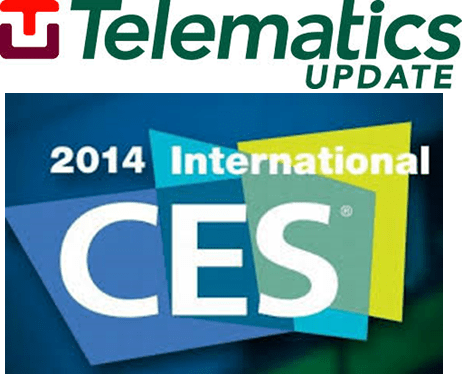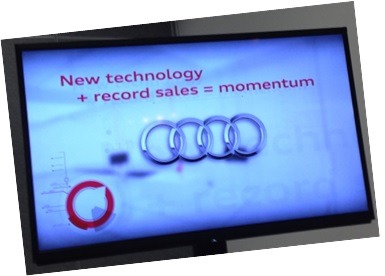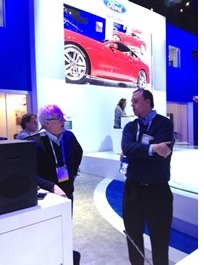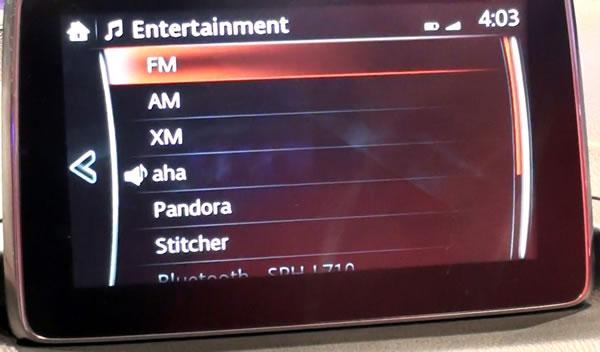 A trend that you can take to the bank about CES is the continued emphasis on two platforms that are very near and dear to radio – smartphones and “connected cars.” These are obviously areas that are at Ground Zero to us at Jacobs Media and jacAPPS as we continue to learn from our annual Las Vegas trips to CES.
A trend that you can take to the bank about CES is the continued emphasis on two platforms that are very near and dear to radio – smartphones and “connected cars.” These are obviously areas that are at Ground Zero to us at Jacobs Media and jacAPPS as we continue to learn from our annual Las Vegas trips to CES.
This week was even more special because we had the opportunity to spend our first day in Sin City at the Telematics Update conference at the Rio. Last spring, we attended our first Telematics Update show here in Detroit. This Vegas edition was loaded with strong content that set the tone for CES week.
Clearly, connectivity, the customer experience, and data are at the epicenter of many OEM efforts to succeed in the space. More and more, it’s about providing a seamless and simple experience that allows consumers to connect their smartphones – and all the infotainment they contain – to the vehicles they drive.
And everyone’s getting into the act. At Telematics Update, a joint presentation by Jaguar/Land Rover and Bosch revealed a new platform for the “digital dash.” For Jaguar/Land Rover (and yes, iHeart Radio comes loaded in), it’s called “In-Control Apps” (there’s the A-word); Bosch is marketing the same product to any and all OEMs that are interested with different brand packaging using the name MySpin.
That’s an ongoing trend – no standardization per se across the various auto manufacturers’ platforms, as each is striving to find th e answers, the system, the applications, and the avenues that will lead to brand dominance and revenue.
e answers, the system, the applications, and the avenues that will lead to brand dominance and revenue.
Audi was one of the stars of CES with its big announcement about the integration of the Android platform into their “connected car” platform. But their offerings go beyond Google Maps and Point of Interest search. Audi is aiming for simplicity, and you can see that clearly in their in-car systems – fewer buttons to confuse the consumers and even a way to essentially “finger paint” on the mouse wheel to start an in-car search.
As Audi America President Scott Keogh told a packed press conference on Tuesday, the company has shown a four year commitment to improving and innovating in this space. Perhaps not coincidentally, Audi has experienced four years of record growth. And in that same time period, generating $10,000 more per vehicle.
Coincidence? Keogh and Audio think not. And one of their concluding slides (right) said it all about Audi’s commitment to the “connected car” space.
Over at Mazda, there’s a growing commitment to keeping their platform simple. Broadcast radio fans will be happy to learn that when you select the “radio” option, the actual pecking order the driver sees is:
I asked how they arrived at this priority list and was told that it’s driven by actual usage – a good sign. I’m not sure that’s accurate, but hey – we’ll take it.
And to give you an idea of the creativity that’s occurring in the space, check out this little piece of video I shot that shows you how the broadcast radio array is displayed on the Mazda 3 and how much fun it is to move around the “digital dial” that looks very old school and familiar – and that’s what makes it cool. You can move around from stations with the console “mouse” or by touch, as you can here:
Chevy is making the full-scale commitment to Wi-Fi hot spots, providing 4G LTE hotspots in vehicles ranging from Vettes to Malibus. As many as seven devices can be connected (AT&T is the partner) to keep mom, dad, and the soccer team happy. Again, connectivity, ease of use, and “anytime, anywhere” are consistent themes.
And not surprisingly, our CES journey ended up at the Ford exhibit (“booth” does not do this massive display justice). Aside from the 50th anniversary Mustang on display, Ford SYNC AppLink partners (including NPR, and jacAPPS) were demoing the integration of apps into Ford’s voice command module.
 Paul Jacobs (on the left in picture) was on the floor for a couple hours, presenting broadcast radio’s case to CES attendees – another reminder of the power of AM/FM radio and its place in “connected cars.” And it’s also essential for Ford (and the other OEMs) to see radio’s interest and commitment in these “digital dash” platforms.
Paul Jacobs (on the left in picture) was on the floor for a couple hours, presenting broadcast radio’s case to CES attendees – another reminder of the power of AM/FM radio and its place in “connected cars.” And it’s also essential for Ford (and the other OEMs) to see radio’s interest and commitment in these “digital dash” platforms.
And that’s why we attend CES and events like Telematics Updates. It’s an opportunity to connect (pun intended) with the automotive community – to better understand their needs, views, and priorities. With DASH, our effort was about education and partnership. Coming up this spring in Detroit, Telematics Update will once again be on hand, and we urge radio to step up and be present.
There is no more important issue facing radio today than its place, value, and opportunity in the cars of today and tomorrow.
Everything we saw this year in Las Vegas will be amplified at CES next year. We sincerely hope to see more of you – including radio’s power players – at the Las Vegas Convention Center.
- For Radio, Will It Be Christmas In April (And Hopefully, May)? - April 21, 2025
- Media And Technology In 2025: Believe It Or Not! - April 18, 2025
- In Radio, You Just Never Know - April 17, 2025






I can’t help but compare the auto industry’s commitment to improving the CE and the corresponding results to those from terrestrial radio.
What would the auto industry be featuring at CES if their commitment to R+D was comparable to what radio is doing? Probably a push button radio that’s cheaper to manufacture, with options for broad format categories (Rock, CHR, Country, Urban, News, Talk, ect.) instead of dial positions. Extreme and inflammatory you say? Consider that for 20 years virtually almost all of the evolution in radio has been on the cost side – change the music and today’s stations sounds pretty much like ones from 1993. Except that the morning show is likely syndicated and most or all of the day is tracked.
Virtually every proclamation from radio’s leaders revolves around how much old turf they’ve managed to retain and virtually nothing about anything new. Isn’t bragging about how Pandora isn’t radio kind of like bragging about how a vehicle that doesn’t have a push button radio/cassette player isn’t a car?
Here’s an idea that will never come to fruition: One of the big radio companies (or better yet all of them) should hire a top R+D person from the auto industry to focus on the CE for radio – give them a reasonable busget…and implement what they recommend.
Seriously – compare that video that Fred shot to what an analogous radio video would show – an automation system and email with phonetic spellings of local cities and towns.
Radio’s leaders should be embarrassed about how little they’ve done to respond to competitive medial challenges and how lucky they are despite that.
But they aren’t.
In this environment, Bob, playing offense is the only way to play. We truly need to see more radio leaders at conferences like CES & Telematics Updates. The vibe, the spirit, and the innovation is contagious, and that’s a “bug” that radio needs to catch. Thanks for the passion, the readership, and for taking the time.
Today, telematics embraces far more than traffic, navigation and antitheft technology. The category also includes infotainment systems, parking assist technology, crash avoidance, location-based information services, vehicle maintenance reminders, and the applications continue to increase. It is an area where OEMs can differentiate their products.